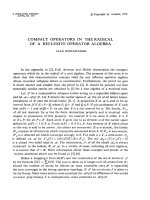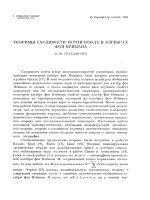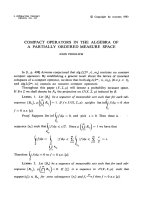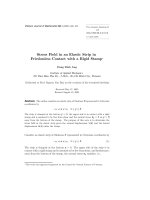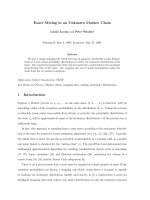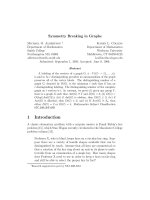Báo cáo toán học: "Colorful Paths in Vertex Coloring of Graphs" pps
Bạn đang xem bản rút gọn của tài liệu. Xem và tải ngay bản đầy đủ của tài liệu tại đây (140.15 KB, 9 trang )
Colorful Paths in Vertex Coloring of Graphs
Saieed Akbari
∗
Department of Mathematical Sciences,
Sharif University of Technology,
Tehran, Iran
School of Mathematics,
Institute for Research in Fundamental Sciences(IPM),
Tehran, Iran
s
Vahid Liaghat
Computer En gineering Department,
Sharif University of Technology,
Tehran, Iran
Afshin Nikzad
Computer En gineering Department,
Sharif University of Technology,
Tehran, Iran
Submitted: Nov 16, 2009; Accepted: Dec 22, 2010; Published: Jan 12, 2011
Mathematics Subject Classification: 05C15
Abstract
A colorful path in a graph G is a path with χ(G) vertices whos e colors are differ-
ent. A v-colorful path is such a path, starting from v. Let G = C
7
be a connected
graph with maximum degree ∆(G). We show that there exists a (∆(G)+1)-colorin g
of G with a v-colorful path for every v ∈ V (G). We also prove that this result is
true if one replaces (∆(G) + 1) colors with 2χ(G) colors. If χ(G) = ω(G), then
the result still holds for χ(G) colors. For every graph G, we show that there exists
a χ(G)-coloring of G with a rainbow path of length ⌊χ(G)/2⌋ starting from each
v ∈ V (G).
Keywords: Vertex-coloring, Colorful path, Rainbow path
1 Introduction
Throughout this paper all g r aphs are simple. Let G be a gr aph and V (G) be the vertex
set of G. In a co nnected graph G, for any two vertices u, v ∈ V ( G ) let d
G
(u, v) denote the
∗
Corresponding author. S. Akbari
the electronic journal of combinatorics 18 (2011), #P17 1
length of the shortest path between u and v in G. We denote the DFS tree in G rooted
at v by T (G, v) (which is defined in [2 , p.13 9]). For every u ∈ V (G), each vertex on the
path between u and v in T (G, v) is called an ancestor of u. By Theorem 6.6 of [2], in
every DFS tree if w and w
′
are adjacent, then one of them is a ncestor of another.
In a graph G, a k-coloring of G is a function c : V (G) → {0, . . . , k − 1} such that
c(u) = c(v) for every adjacent vertices u, v ∈ V (G ) . The chromatic number of G denot ed
by χ(G), is the smallest k for which G has a k-coloring. For simplicity we denote a
χ(G)-coloring of G by χ-coloring. For a coloring of graph G, we say path P of G is a
rainbow path if all vertices of P have different colors. A v-rainbow path is a rainbow path
starting from the vertex v. A v-colorful path is a rainbow path starting from the vertex
v with χ(G) vertices. The colorful paths and r ainbow paths have been studied by several
authors, see [4], [5] and [6].
For each u ∈ V (G), let N(u) be the set of all vertices a djacent to u. We denote a cycle
of order n by C
n
. Also we denotes the size of the maximum clique in G by ω(G). A good
cycle in a graph G is a cycle of order ℓ in which ℓ ≥ χ(G) and ℓ = 0 or ℓ = 1 (mod χ(G)).
2 The Existence of (∆(G)+1)-Colorings with Colorful
Paths
Let G be a graph. We recall that a path in G is said to represent all χ(G) colors if all the
colors 0, . . . , χ(G) − 1 appear on this path. The following problem was posed in [6].
Problem. Let G be a connected graph. Does there always exist a proper vertex col-
oring of G with χ(G) colors such that every vertex of G is on a path with χ(G) vertices
which represents all χ(G) colors?
The following conjecture was proposed in [1].
Conjecture. Let G = C
7
be a connected graph. Then there exists a χ(G)-coloring of G
such that for every v ∈ V (G), there exists a v-colorful path.
In [1] it is shown that the local version of conjecture is true, that is for an arbitrar y
v ∈ V (G), there exists a χ-coloring of G with a v-colorful path. We start with the
following theorem.
Theorem 1 Let G = C
7
be a connected graph. If G contains a good cycle, then there is
a (∆(G) + 1)-coloring of G with a v-colorful path for every v ∈ V (G).
Proof. For complete graphs the assertion is trivial. Fig.1 shows a proper 3-co lo r ing for
odd cycles except C
7
, with a v-colorful path fo r every v ∈ V (G). Thus assume that G is
neither an odd cycle nor a complete graph.
Assume that C is a good cycle of the minimum order k in G, with vertices v
0
, v
1
, . . .,
v
k−1
, such that k = 0 or k = 1 (mod χ(G)). For every i, 0 ≤ i ≤ k − 1 , we color the
the electronic journal of combinatorics 18 (2011), #P17 2
(c + 2)mod 3
1
2
0
c
c
0
2
1
0
(c + 1)mod 3
Figure 1: Colo r ing of odd cycles not isomorphic to C
7
vertex v
i
by i mod χ(G) using the colors 0, . . . , χ(G) − 1. In the case k = 1 (mod χ(G ) ),
we color v
k−1
by the color χ(G) and call v
k−1
by v
∗
. Note that because of the minimality
of the order of C, there is no edge between two vertices of the same color and for each
i, 0 ≤ i ≤ k − 1, there is a v
i
-colorful pa th on C. As a consequence of Brooks’ Theorem
(Theorem 14.4 of [2]), in the coloring of C we use at most ∆(G) + 1 colors. For each i,
0 ≤ i ≤ k − 1, let father of v
i
(for abbreviation F (v
i
)) be v
((i+1) mod k)
.
Now, we provide an alg orithm to color the remaining vertices of G with ∆(G)+1 colors
such that there is a v-colorful path for each v ∈ V (G). For simplicity, define Next(t) the
color (t + 1) mod (∆(G) + 1), for every t, 0 ≤ t ≤ ∆(G).
In each step of the algorithm, let u be one of the vertices with no color, but adjacent
to some colored vertices. Let c(N(u)) be the set of all colors appeared in the neighbors
of u. Since | c( N(u))| ≤ ∆(G), we can choose an available color t such that t /∈ c(N(u))
but Next(t) ∈ c(N(u)).
Let F (u) be one of the vertices in N(u) whose color is Next(t). Assign the color t to
u and continue the algorithm until all vertices are colored.
Obviously the algorithm produces a pro per coloring c. Now, we show that there is a
u-colorful path. Consider the following sequence of the vertices Q(u) : q
1
, . . . , q
χ(G)
such
that q
1
= u and for every i, 1 < i ≤ χ(G) : q
i
= F(q
i−1
). We prove that Q(u) is a
u-colorful path. We claim that the colors of q
1
, . . . , q
χ(G)
are distinct.
The proof is by contradiction. It can be easily checked that the following holds:
c(q
i+1
) =
c(q
i
) + 1 (mod (∆(G) + 1)) if q
i
/∈ C
c(q
i
) + 1 (mod χ(G)) if q
i
, q
i+1
∈ C\{v
∗
}
c(q
i
) + 1 (mod (χ(G) + 1)) if q
i
= v
∗
or q
i+1
= v
∗
.
Assume that for some a = b, c(q
a
) = c(q
b
). It is clear that for some i, a ≤ i < b,
c(q
i
) = 0. Let M = max{ i | i < b, c(q
i
) = 0 }. The colors of the vertices q
M
, q
M+1
, . . . , q
b
are 0, 1, . . . , c( q
b
), respectively. Since the number of vertices of Q(u) is χ(G), we have
0 < c(q
b
) < χ(G).
the electronic journal of combinatorics 18 (2011), #P17 3
Now, let m = min{ i | a < i, c(q
i
) = 0 }. Since c(q
a
) = 0, we have m ≤ M. The
number of vertices in the sequence q
M
, . . . , q
b
is exactly c(q
b
) + 1. Since c(q
m
) = 0,
c(q
m−1
) ∈ {χ(G)−1, χ(G), ∆(G)}. So the number of vertices in the sequence q
a
, . . . , q
m−1
is at least χ(G) − c(q
a
). Therefore the number of vertices of Q(u) should be at least
χ(G) + 1, a contradiction. The claim is proved. ✷
Before stating our main results, we need to prove another theorem.
Lemma 1 Let G be a connected graph with no cycle of order χ(G). For a given vertex
v, there exists u ∈ V (G) such that 2χ(G) − 2 ≤ d
T (G,v)
(u, v).
Proof. Let T = T (G, v). If for every w ∈ V (G), 2χ(G) − 2 > d
T
(w, v), then we show
one can properly color the vertices of G using χ(G) − 1 colors. To see this we define
a coloring c as follows. For every w ∈ V (G), let c(w) = d
T
(w, v) (mod (χ(G) − 1 )) .
Assume that w
1
, w
2
∈ V (G) are adjacent and c(w
1
) = c(w
2
). Since T is a DFS tree, with
no loss of generality we can suppose tha t w
1
is an ancestor of w
2
. Thus d
T
(w
1
, w
2
) =
0 (mod ( χ(G)−1)). If d
T
(w
1
, w
2
) = χ(G)−1, then d
T
(w
2
, v) ≥ 2χ(G)−2; a contradiction.
Hence d
T
(w
1
, w
2
) = χ(G)− 1. Since w
1
and w
2
are adjacent we find a cycle of order χ(G);
a contradiction. ✷
The f ollowing theorem proves the assertion of Theorem 1 for the graphs with no good
cycle.
Theorem 2 Let G = C
7
be a connected graph. If G has no good cycle, then there is a
(∆(G) + 1)-coloring of G with a v-colorful path for every v ∈ V (G).
Proof. As we see in the proof of Theorem 1, the assertion holds for odd cycles except
C
7
. Thus assume that G is not an odd cycle. Let v be an arbitrary vertex of G and
T = T (G, v). By Lemma 1, there exists a vertex u such that 2χ(G) − 2 ≤ d
T
(u, v).
Let P : v = p
0
, p
1
, . . . , p
k
= u be the path between v and u in T . Let Q represent
the set of vertices of G whose ancestors(including the vertex itself) are not in the set
{p
χ(G)−1
, p
χ(G)
, . . . , p
k
}. Define S = Q\P (See Fig.2).
For each w ∈ V (G)\S, color w with d
T
(w, v) mod χ(G). Since there are no good
cycles in G, therefore the coloring of V ( G )\S is proper. For each w ∈ Q\S, there is a
w-colorful path in V (G)\S going downward in T t hro ugh P , by passing from each vertex
to its child in P. For each w ∈ V (G)\Q, there is a w-colorful path in V (G)\S going
upward in T by passing from each vertex to its parent.
So for each w ∈ V (G)\S, there is a w-colorful path. All uncolored vertices are
contained in S. We color them in such a way that for each w ∈ S there exists a
vertex w
′
∈ N(w), where c(w
′
) = Next(c(w)). Recall that for a color t, Next(t) =
(t + 1) mod (∆(G) + 1 ) . We deno te w
′
by F (w). Since T is a DFS tree there are no edges
between S and V (G)\Q. Therefore F(w) ∈ Q. Such coloring can be obtained using the
algorithm discussed in the proof of Theorem 1. Now, we show that fo r each w ∈ S, there
exists a w-colorful path.
the electronic journal of combinatorics 18 (2011), #P17 4
p
0
(= v)
S
p
(χ(G)+1)
p
χ(G)
p
2
p
1
p
k
(= u)
p
(χ(G)−1)
V \(S ∪ P)
Figure 2: The DFS tr ee T , rooted at v. This figure illustrates only the edges of T .
For every i, 0 ≤ i ≤ k − 1, let F (p
i
) = p
i+1
. Consider the sequence of the vertices
Q(w) : q
0
(= w), . . . , q
χ(G)−1
, where F (q
i
) = q
i+1
, for every i, 0 ≤ i < χ(G) − 1. Note that
for each i, 0 ≤ i < χ(G) − 1, c(q
i+1
) is either Next(c(q
i
)) or c(q
i
) + 1 (mod χ(G)). Hence
there are no vert ices with the same color in Q(w). Therefore Q(w) is a w-colorful path. ✷
The following theorem shows that for every graph G the conj ecture is true for ∆(G)+1
colors instead of χ(G) colors. In [1] it was proved that the conjecture is true fo r χ(G) +
∆(G) − 1 color s. The following theorem is a n improvement of this result.
Theorem 3 Let G = C
7
be a connected graph. Then there is a (∆(G) + 1)-coloring of G
with a v-colorful path, for every v ∈ V (G).
Proof. If G = C
7
contains a good cycle, then by Theorem 1 there is a (∆(G)+1) -coloring
of G with a v-colorful path, for every v ∈ V (G). Thus, we may assume that G does not
have a good cycle. In this case, Theorem 2 shows that there is a (∆(G) + 1)-coloring o f
G with the same properties. ✷
3 The Existence of (2 χ ( G))-Colorings with Colorful
Paths
Let c be a χ-coloring of a g iven graph G. Let G
c
be a directed graph with the same vertex
set of G which has a directed edge fro m u to v if and only if (i) u a nd v are adjacent in
G; and (ii) c(v) = c(u) + 1 (mod χ(G)).
the electronic journal of combinatorics 18 (2011), #P17 5
Lemma 2 Let c be a χ-coloring of a connected graph G. For a given subgraph H of G,
there exists a χ-coloring c
′
, such that for every v ∈ V (H), c
′
(v) = c(v) and for every
u ∈ V (G ) , there is a directed path from u to at least one of the vertices of V (H) in G
c
′
.
Proof. Fo r an arbitrary χ-co loring of G like c, a vertex u in G
c
is called nice if there
exists a directed path from u to a vertex of H. Assuming that we have a χ-coloring c,
we give a polynomial- time algorithm to obtain the coloring c
′
from c, such that all the
vertices are nice. Let c
′
= c and let S ∈ V (G) be the set of all vertices of G which are not
nice in c
′
. We will decrease |S|, by modifying c
′
in each iteration of the algor ithm. After
at most |V | iterations, all the vertices would be nice.
In each iteration, we do as follows:
Let c
′
i
, for i, 1 ≤ i < χ(G), be the coloring of G such that:
c
′
i
(v) =
c
′
(v) if v /∈ S
c
′
(v) + i ( mod χ(G)) if v ∈ S.
Since G is connected, at least one of these colorings is not proper. Assume that t is the
smallest natural number for which c
′
t
is not pro per. By the definition of S, there is no
directed edge from S to V (G)\S in G
c
′
. Hence c
′
1
is proper. Now, consider the proper
coloring c
′
t−1
. Since c
′
t
is not proper, there are two adjacent vertices u ∈ S and v /∈ S such
that c
′
t−1
(u) + 1 = c
′
t−1
(v) (mod χ(G)). Therefore u is also a nice vertex in G
c
′
t−1
. Now,
let c
′
be c
′
t−1
and continue with t he next iteration (note that the vertices o f G\ S remain
nice in c
′
and u becomes a nice vertex).
After at most |V | iterations the algorithm will find a coloring c
′
such that all vertices
are nice, and each iteration can be implemented in O(|V | + |E|) time (by considering the
edges between S and G\S). ✷
We denote the χ-coloring c
′
, given in the proo f of Lemma 2, by C(G, H, c). Next
theorem shows that for every graph G the conjectur e holds if one replaces χ(G) colors
with 2χ(G) colors.
Theorem 4 Let G be a connected graph. Then there exists a 2χ(G)-coloring of G with
a v-colorful path for every v ∈ V (G).
Proof. Let H = C when there is a cycle C of order χ(G) or χ(G) + 1, otherwise let
H be the path with 2 χ(G ) − 1 vertices according to Lemma 1. In either case, choose an
arbitrary vertex of H and call it by v
∗
. L et c b e a χ-coloring of G and set c
′
= C(G, v
∗
, c).
Now we recolor vertices of H with at most χ(G) new colors χ(G), . . . , 2χ(G) − 1 such
that:
• If H is a cycle, then color vertices of H\v
∗
with one of the colors χ(G), . . . , 2χ(G)−1.
Color v
∗
as the same as its color in C(G, v
∗
, C).
• If H : p
0
, . . . , p
2χ(G)−2
is a path, then color p
i
with χ(G) + (i mo d χ(G)).
the electronic journal of combinatorics 18 (2011), #P17 6
We first claim that c
′
is a proper coloring. This is trivial in the first case. In the case
H is a pa t h P, if there are two adjacent vertices u, v ∈ V (G) with the same color in c
′
,
then u, v ∈ V (P ), because V (G)\H is properly colored with the colors 0, . . . , χ(G) − 1
and H is colored with the colors χ(G), . . . , 2χ(G) − 1. Let p
i
= u and p
j
= v. With
no loss of generality suppose that i < j. Note that in the coloring of P , we should have
i = j (mo d χ(G)). So the vertices p
i
, . . . , p
j
form a cycle of o rder χ(G)+1, a contra diction.
Now, we show that for each v ∈ V (G), there is a v-colorful path in c
′
.
Case 1. H is a cycle with the vertices D : v
0
, . . . , v
k
, where k = χ(G) − 1 or χ(G).
Let v be an a r bitrar y ver tex of G . If v ∈ D, then it is clear that there is a v-colorf ul
path in D. If v /∈ D, then by Lemma 2, there exists a directed path starting from v and
ending to v
∗
in G
f
, where f = C(G, v
∗
, c). Ca ll this path by Q : q
0
(= v), . . . , q
k
(= v
∗
). If
k ≥ χ(G) − 1, then q
0
, . . . , q
χ(G)−1
is a v-colorful path. So assume that k < χ(G) − 1. Let
i be the smallest index such that q
i
∈ D. Consider the q
i
-colorful path in D and call it
by Q
′
: q
′
0
(= q
i
), . . . , q
′
χ(G)−1
. We claim that Q
′′
: q
0
, . . . , q
i
, q
′
1
, . . . , q
′
χ(G)−i−1
is a v-colorful
path. The vertices of D are differently colored with the colors c(v
∗
), χ(G), . . . , 2χ(G) − 1.
Since k < χ(G) − 1, there a r e no vertices colored with c(v
∗
) in {q
0
, . . . , q
i
}. Therefore Q
′′
is a v-colorful path.
Case 2. H is a path P . Let v be an arbitrary vertex of G. If v ∈ V (P ), then ac-
cording to the length of P , there is a v-co lo r ful path in P. If v /∈ V (P ), then by Lemma 2,
there is a directed path starting from v a nd ending to v
∗
in G
f
, where f = C(G, v
∗
, c). Call
this path by Q : q
0
(= v), . . . , q
k
(= v
∗
). Let i be the smallest index such that q
i
∈ V (P ). If
i ≥ χ(G)−1, then q
0
, . . . , q
χ(G)−1
is a v-colorful path. If i < χ(G)−1, then consider the q
i
-
colorful pa th in P and call it by Q
′
: q
′
0
(= q
i
), . . . , q
′
χ(G)−1
. Then q
0
, . . . , q
i
, q
′
1
, . . . , q
′
χ(G)−i−1
is a v-colorful path and the proof is complete. ✷
4 Long Rainbow Paths in χ(G)-Colorings
The following theorem shows that fo r every graph G with χ(G) = ω(G), the conjecture
is true.
Theorem 5 Let G be a graph with ω(G) = χ(G). Then there exists a χ(G)-coloring of
G with a v-colorful path for every v ∈ V (G).
Proof. Assume that M = {v
1
, . . . , v
χ(G)
} is a maximum clique in G. We claim that
the assertion holds for the coloring f = C(G, M, c), where c is an arbitrary coloring of
G. By Lemma 2, fo r every v ∈ V (G), there exists a directed path in G
f
, star ting from
v and ending in M. Call this path by P : p
1
, . . . , p
k
. Let M
′
= {u
1
, . . . , u
χ(G)−k
} be a
subset of M such that for every j, 1 ≤ j ≤ χ(G) − k, c(u
j
) /∈ {c(p
1
), . . . , c(p
k
)}. Clearly,
p
1
, . . . , p
k
, u
1
, . . . , u
χ(G)−k
is a v-colorful path. ✷
the electronic journal of combinatorics 18 (2011), #P17 7
In the previous theorems, we proved the existence of v-colorful paths (rainbow paths
of length χ(G)), for every v ∈ V (G), using a set of colors with different sizes. We close
this paper by showing that there are some χ- color ings of G in which there exist long
v-rainbow paths, for every v ∈ V (G).
Theorem 6 Let G be a connected graph. Then there is a χ(G)-coloring of G in which
for every v ∈ V (G), there exists a v-rainbow path of length ⌊
χ(G)
2
⌋.
Proof. Let c be a χ-coloring of G. As a consequence of Proposition 5 in [3], there is a
path P : p
0
, . . . , p
χ(G)−1
such that
c(p
i
) =
i if 0 ≤ i ≤ m
χ(G) + m − i if m + 1 ≤ i ≤ χ(G) − 1,
where m = ⌊
χ(G)−1
2
⌋. L et c
′
= C(G, P, c). By Lemma 2, for every v ∈ V (G), there is a
path Q(v) : v = q
1
, . . . , q
k
= p
s
, where c
′
(q
i+1
) = c
′
(q
i
) + 1 (mod χ(G)) for 1 ≤ i < k.
With no loss of generality, assume that q
k
∈ V (P ) and q
i
/∈ V (P ) for each i, 1 ≤ i ≤ k −1.
Let Q
′
(v) : q
′
1
, . . . , q
′
k+⌊
χ(G)
2
⌋
be the path of length k + ⌊
χ(G)
2
⌋ − 1 such that
q
′
i
=
q
i
if 1 ≤ i ≤ k
p
s+(i−k)
if k + 1 ≤ i ≤ k + ⌊
χ(G)
2
⌋ and s ≤ m
p
s−(i−k)
if k + 1 ≤ i ≤ k + ⌊
χ(G)
2
⌋ and m < s.
We claim that the first ⌊
χ(G)
2
⌋ + 1 vertices of Q
′
(v) for m a v-rainbow path. We prove this
in the case s ≤ m. The other case(s > m) is similar.
Let t be the integer that q
′
t
= p
m
. If t ≥ ⌊
χ(G)
2
⌋ + 1, then it is clear that there is a
v-rainbow path of length ⌊
χ(G)
2
⌋. Thus assume that t ≤ ⌊
χ(G)
2
⌋. We have
• c
′
(q
′
i+1
) = c
′
(q
′
i
) + 1, for i, 1 ≤ i < t; and
• c
′
(q
′
i
) = c
′
(q
′
i+1
) + 1, for i, t + 1 ≤ i ≤ ⌊
χ(G)
2
⌋.
Therefore, c
′
(q
′
i
) ∈ {0, . . . , m} for i, 1 ≤ i ≤ t, and c
′
(q
′
i
) ∈ {m + 1, . . . , χ( G ) − 1} for i,
t + 1 ≤ i ≤ ⌊
χ(G)
2
⌋ + 1. Hence the color of the vertices of q
′
1
, . . . , q
′
⌊
χ(G)
2
⌋+1
are distinct and
this path is a v-rainbow path. ✷
Acknowledgments. The authors wish to express their deep gratitude to the referee of
the paper for making valuable suggestions. The research of the first author was in part
suppo r t ed by a grant from IPM (No. 89050212).
the electronic journal of combinatorics 18 (2011), #P17 8
References
[1] S. Akbari, F. Khaghanpoor, S. Moazzeni, Colorful paths in vertex coloring of graphs,
submitted.
[2] J.A. Bondy, U.S.R. Murty, Graph Theory, Graduate Texts in Mathematics, 244.
Springer, New York, 2 008.
[3] D. de Werra and P. Hansen, Variations on the Roy-Gallai Theorem, 4OR 3 (2005)
245-251.
[4] T.S. Fung, A colorful path, The Mathematical Gazette 73 (1989) 186-188.
[5] H. Li, A generalization of the Gallai-Roy theorem, Graphs and Combinatorics 17
(2001) 681-685.
[6] C. Lin, Simple proofs of results on paths representing all colors in proper vertex-
colorings, Graph and Combinatorics 2 3 (2 007) 201 -203.
the electronic journal of combinatorics 18 (2011), #P17 9
